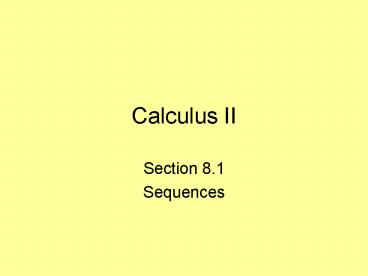Calculus II PowerPoint PPT Presentation
1 / 21
Title: Calculus II
1
Calculus II
- Section 8.1
- Sequences
2
Infinite Series
The importance of series and sequences stems from
Newtons idea of representing functions as sums
of infinite series. These series can be thought
of as infinite polynomials, and if a function can
be represented in this way, then it can be
integrated by integrating the terms of this
series. The importance of these infinite
polynomials (called power series) arises from the
fact that they can be used to evaluate
nonelementary integrals and solve differential
equations. Many of the functions that arise
in mathematical physics and chemistry, such as
Bessel functions, are defined as sums of series,
so it is important to be familiar with the basic
concepts of convergence of infinite sequences and
series.
3
A sequence can be thought of as a list of numbers
written in a definite order
How might we think of a sequence as a function?
Consider the sequence 1, 3, 5, 7, ... .
4
Definition
An infinite sequence (or sequence) of numbers is
a function whose domain is the set of integers
greater than or equal to some integer n0.
5
Notation
Sequence are functions, so we will use function
notation to represent them.
Consider the sequence
Conventional notation for sequence
6
Examples
diverges
converges
converges
diverges
converges
7
Definition
A sequence an has the limit L and we
write if we can make the terms an as close
to L as we like by taking n sufficiently large.
If exists, we say the
sequence converges (or is convergent).
Otherwise, we say the sequence diverges (or is
divergent).
8
Recursive Definitions
So far, we have calculated each an directly from
the value of n. But sequences are often defined
recursively by giving 1. The value(s) of the
initial term or terms, and 2. A rule, called a
recursion formula, for calculating any later
term from terms that precede it.
The Fibonacci sequence is defined recursively.
9
Subsequences
If the terms of one sequence appear in another
sequence in their given order, we call the first
sequence a subsequence of the second sequence.
Subsequences are important for two reasons
1. If a sequence an converges to L, then all
of its subsequences converge to L.
2. If any subsequence of a sequence an
diverges, or if two subsequences has
different limits, then an diverges.
Consider
10
Theorem
If and when n
is an integer, then
11
Example f(x) 1/x
12
Theorem 2
If and are convergent sequences and
c is a constant, then
1. 2. 3. 4. 5. 6.
13
Squeeze Theorem for Sequences
Let , , and be sequences of
real numbers. If holds for all n n0, and
if, then
14
Theorem
If , then
15
Definition
A sequence an with the property that an an1
for all n is called nondecreasing sequence.
16
Definition
A sequence an is bounded from above if there
exists a number M such that an M for all n.
The number M is an upper bound for an. If M
is an upper bound for an but no other number
less than M is an upper bound for an, then M is
the least upper bound for an.
17
Theorem 1 The Nondecreasing Sequence Theorem
A nondecreasing sequence of real numbers
converges if and only if it is bounded from
above. If a nondecreasing sequence converges, it
converges to its least upper bound.
18
Definition
A sequence an with the property that an an1
for all n is called nondecreasing sequence.
It is called nonincreasing if an an1 for all
n. A sequence is monotonic if it is either
nondecreasing or nonincreasing.
19
Definition
A sequence an is bounded from above if there
exists a number M such that an M for all n.
The number M is an upper bound for an. If M is
an upper bound for an but no other number less
than M is an upper bound for an, then M is the
least upper bound for an. The sequence is
bounded from below if there exists a number m
such that m an for all n. The number m is a
lower bound for an. If it is bounded form
above and below, the an is a bounded sequence.
20
Theorem 5 Monotonic Sequence Theorem
Every bounded, monotonic sequence is convergent.
21
(No Transcript)

